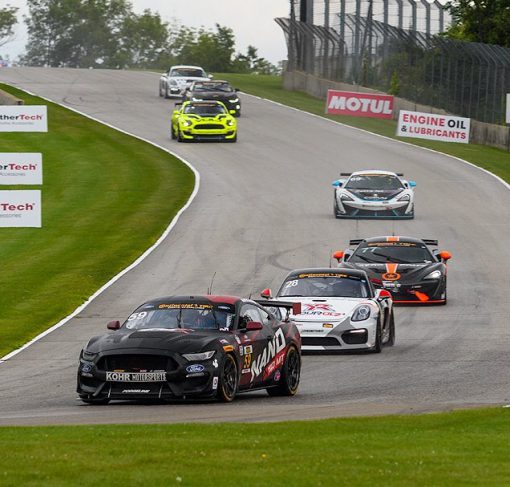The world of automobile road racing is generally divided into two areas: open-wheel or formula cars; and closed-wheel (and usually, though not always, roofed – hence the moniker “tin-top”) sports and touring cars, often based upon production vehicles.
Prototypes
The world’s foremost sports car racing series is the FIA World Endurance Championship (WEC). Season highlight, and as of the 2019/2020 season the final race of the schedule, is the Le Mans 24 Hours race. The other races are all at least four hours in length. The WEC has two prototype classes. LMP1 prototypes are the top class, with hybrid drivetrains being permitted. Almost everything is allowed engine-wise, with just the minimum weight, fuel tank size, and fuel flow being regulated. LMP2 prototypes use a 4.2l V8 developing 600hp, and are a bit heavier at 930kg.
The IMSA WeatherTech SportsCar Championship is the American counterpart to the FIA WEC. Season highlights are the Daytona 24 Hour race, the Sebring 12 Hour race, and the Petit Le Mans at Road Atlanta. The main prototype class is DPI (Daytona Prototype International) prototypes. DPIs are similar to LMP2s, with slightly different bodywork. LMP2 prototypes are eligible as well.
GTE
The GTE (FIA WEC) or GT LM (IMSA) cars are based on production cars, but major changes are allowed – for example, on the Porsche 911 RSR the engine is rotated to create a mid-engined car. Cars have about 500hp with a weight of around 1,250kg. The regulations for GTE cars (as well as LMP1 and LMP2) set by the ACO (Automobile Club d’Ouest), the organiser of the Le Mans 24 hours. GTE cars are subject to Balance of Performance (BOP). This means that certain parameters such as weight, air restrictor diameter, and fuel tank volume are used to achieve similar performance for the different cars.
The FIA WEC differentiates between two GTE classes: GTE Pro and GTE Am. GTE Am class uses cars that are at least a year old (i.e. previous year’s car) and mix pro and amateur drivers.
GT3
As there was a time when the top sports car class was called GT1 and what is now GTE was called GT2, the third class is called GT3. It is regulated by the SRO (Stephane Ratel Organisation). GT3 cars are production-derived (though with significant modifications allowed, such as converting four-wheel drive cars to rear-wheel drive) with about 450hp and subject to Balance of Performance. GT3 has proven a huge success, with eleven different cars/manufacturers currently being eligible for GT3.
There are a multitude of race series using SRO GT3 regulations, both at national and international level. IMSA has a GT3 class. The most important GT3 series is the Blancpain GT series. It consists of five longer (Endurance cup) and five shorter (World Challenge) races. Season highlight is the 24 Hour race at Spa-Francorchamps. Other notable GT3 series are the International GT Challenge (consisting of five races of eight hours and longer) and the German ADAC GT Masters. GT3 classes are also part of the 24 Hour series and the VLN Nürburgring.
GT4
The fourth and final sports car class is GT4. It aims at amateurs and younger drivers, and is also regulated by SRO. GT4 is a similar success to GT3, with many manufacturers selling GT4 cars. The offerings are diverse, from Alpines and KTM X-Bows via Porsche Caymans to Ford Mustangs and Chevrolet Camaros. Besides the SRO-run GT4 series, such as GT European Series and GT4 America, there are also series at the national level (e.g. ADAC GT4 Germany) and GT4 classes in other series.
Super GT/DTM
Starting with the 2019 season, the Japanese Super GT series and the German DTM (Deutsche Tourenwagen Masters) use the same regulations. Despite the Tourenwagen name, the DTM has been using silhouette cars, e.g. purpose-built race cars that only somewhat resemble production cars, since 2000. For 2019, the V8 engines have been replaced by four-cylinder turbo engines developing more than 600hp, making the Super GT/DTM cars faster than GT3 cars.
TCR
TCR is currently the most popular set of regulations for touring cars. Cars use a 2.0l turbo engine with 350hp and weigh around 1,250kg. Front-wheel drive is mandatory, with both production and racing gearboxes being permitted. TCR cars are subject to Balance of Performance. Many manufacturers build TCR cars, and there are many TCR series at the national level and TCR classes in other series, e.g. in the IMSA Michelin Pilot Challenge. The highest-level TCR series is the FIA World Touring Car Cup.
Other touring car regulations
The success of TCR has led to the demise of most other touring car regulations. A notable exception is the British Touring Car Championship (BTCC). There are some similarities between the BTCC Next-Generation Touring Car, such as the use of a turbocharged 2l engine. Drivetrain components are the same for all entries, and both front-wheel and rear-wheel drive are permitted.


